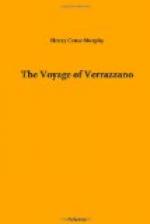&c never found out before the last year, 1562.
Written in French by Captain Ribault &c and now newly
set forthe in Englishe the XXX of May, 1563.
Prynted at London, by Rowland Hall, for Thomas Hacket.”
This translation was reprinted by Hakluyt in his first
work, Divers Voyages, in 1582; but was omitted by
him in his larger collections, and the account by Laudoniere,
who accompanied Ribault, of that and the two subsequent
expeditions, substituted in its stead.] In the relation
written by Laudoniere in 1566, but not printed until
1586, of all three of the expeditions sent out from
France, for the colonization of the French protestants,
mention is again made of the discoveries of Verrazzano.
Laudoniere gives no authority, but speaks of them in
terms which show that he made his compend from the
discourse of the French captain of Dieppe, published
by Ramusio in the same volume, in connection with
the Verrazzano letter. He says that Verrazzano
“was sent by King Francis the First and Madame
the Regent, his mother, into these new countries.”
In thus associating the queen mother with the king
in the prosecution of the enterprise Laudoniere commits
the same mistake as is made in the discourse in that
respect. Louise did not become regent until after
the return of Verrazzano is stated to have taken place,
and after both his letter and that of Carli are represented
to have been written. [Footnote: The edict appointing
Louise regent, was dated at Pignerol, the 17th of October,
1524, when Francis was en route for Milan. Isambert,
Recueil, &c., tom. XII, part I, p. 230.] In adopting
this error it is plain that Laudoniere must have taken
it from the work of Ramusio, as the discourse of the
French captain is found in no other place, and therefore
used that work. He also speaks of the discovered
country being called Francesca, as mentioned in the
discourse. [Footnote: Basanier, L’Histoire
notable de la Floride. (Paris, 1586), fol. 1-3.
Hakluyt, III, p. 305. Ramusio, III, fol. 423.
(Ed. 1556.)]
The Verrazzano discovery is referred to, for the first
time, in any work printed in France, in 1570, in a
small folio volume called the Universal History of
the World, by Francois de Belleforest, a compiler
of no great authority. In describing Canada, he
characterizes the natives as cannibals, and in proof
of the charge repeats the story, which is found in
Ramusio only, of Verrazzano having been killed, roasted
and eaten by them, and then proceeds with a short
account of the country and its inhabitants, derived,
as he states, from what Verrazzano had written to
King Francis. [Footnote: L’Histoire Universelle
du Monde. Par Francois de Belleforest. (Paris
1570, fol. 253-4.)] He does not mention where he obtained
this account, but his reference to the manner in which
Verrazzano came to his death, shows that he had consulted
the volume of Ramusio. Five years later the same
writer gave to the world an enlarged edition of his
work, with the title of The Universal Cosmography




